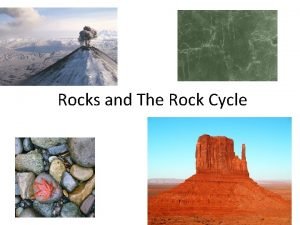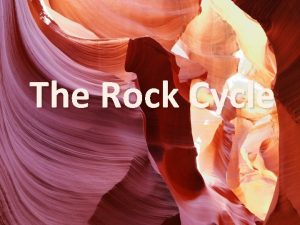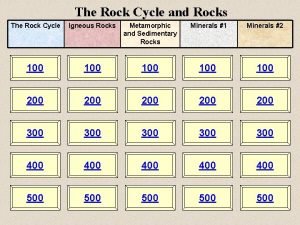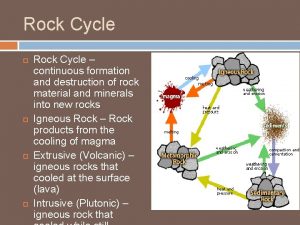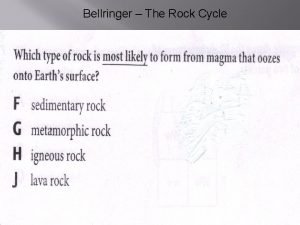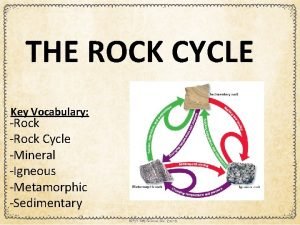Rock Cycle and Rock Types Earths 5 Structures































- Slides: 31

Rock Cycle and Rock Types

Earth’s 5 Structures lithosphere asthenosphere mantle outer core inner core

This slide show is intended to help you understand important types of rocks. The diagram in the next slide represents the ROCK CYCLE—a scheme that represents the processes of continuous changes that connect the three major groups of rocks: SEDIMENTARY IGNEOUS METAMORPHIC It also shows two other important parts of the “Rock Cycle” – SEDIMENTS and molten LAVA and MAGMA


Here is another version of the Rock Cycle


Igneous Rocks Are Separated into Two Main Categories EXTRUSIVE INTRUSIVE

Igneous Rocks • Igneous rocks are rocks that are formed from the crystallization of magma. Heat and melting Magma Cooling and crystallization Igneous Rocks

Sedimentary Rocks Sedimentary rocks may be made of rock fragments—sediments— or by chemical reactions. The classification of sediments is shown below.

Clastic rocks–made of cemented sediments—are classified by their grain sizes.

Non-clastic rocks form by chemical precipitation (settling out from a solution. ) Limestone is made from calcite, chert from quartz, and halite is rock salt.

Biologic sedimentary rocks come from the remains of organic matter. • The most important of these is coal. Anthracite coal results from the greatest pressure and releases the most energy when burned. Other varieties are bituminous and lignite. “Petrified” (permineralized) wood is another organic rock.

More about sedimentary rocks • Shale is the most common sedimentary rock • Sedimentary rocks cover about threequarters of the land surface

Making Sedimentary Rocks • Rocks formed from lithification.

lithification • transformation of sediments into rock through compaction and cementation

Compaction n the process in which pressure squeezed air and water out and pushes fragments together n pressure comes from rock layers above

Cementation n the process in which water and minerals combine to form cement that holds sediment together.

Three Types of Sedimentary Rocks • • • Clastic Sedimentary Rocks Evaporites Sedimentary Rocks Organic Sedimentary Rocks organic - once living

Chemical Sedimentary Rocks • Formed from minerals that were once dissolved in water

Evaporites • Formed when a change in temperature caused water to be evaporated • Examples: Gypsum and Halite GYPSUM HALITE

Organic Sedimentary Rock • formed from the remains of living things • Sedimentary rocks are the only rocks with fossils FOSSILIFOROUS LIMESTONE

Metamorphic Rocks • Are rocks formed from an increase in pressure and temperature deep within the lithosphere.

How are metamorphic rocks classified? Metamorphic rocks are classified by how they are formed.

Three Types of Metamorphic Rocks • Contact Metamorphism – occurs when molten rocks, such as those in an igneous intrusion, come in contact with solid rock

Regional Metamorphism • are produced when high temperature and pressure affect large regions of Earth’s crust. • the grade of regional metamorphism reflects the intensity of temperature and pressure • classified as low grade, intermediate grade, and high grade.

Metamorphic Rocks Are Classified By Their Texture MARBLE IS NONFOLIATED GNIESS IS FOLIATED

Nonfoliated • composed mainly of minerals that form with blocky crystal shapes. – Quartzite and marble are two common examples of nonfoliated rocks.

Foliated • metamorphic rocks are characterized by bands of minerals • high pressure during metamorphism causes minerals with flat or needlelike crystals to form with their long axes perpendicular to the pressure

Chemical Change • When hot fluids, water or magma, migrate in and out of the rock during metamorphism the original composition of the rock can change. • Minerals melt into a liquid state then recombine with other elements to create new minerals.

Mineral Changes • During metamorphism, the minerals in a rock change into new minerals that are stable under the new temperature and pressure conditions.

Locations, types, and ages of the bedrocks are represented in a geologic map http: //www. state. nj. us/dep/njgs/
 How does a igneous rock become a metamorphic rock
How does a igneous rock become a metamorphic rock Example of homologous structure
Example of homologous structure Rock types and cycle quick check
Rock types and cycle quick check The earth's layers foldable
The earth's layers foldable Earths roation
Earths roation Whats a natural satellite
Whats a natural satellite Earths biomes
Earths biomes Periodic table of elements families
Periodic table of elements families Basalt
Basalt Whats earths moon called
Whats earths moon called Whats the thickest layer of the earth
Whats the thickest layer of the earth Earths early atmosphere contained
Earths early atmosphere contained Is lithosphere part of the crust
Is lithosphere part of the crust Earths major crustal plates
Earths major crustal plates Earths orbit seasons
Earths orbit seasons Brown earth soil profile
Brown earth soil profile Study of earth's physical features
Study of earth's physical features Earth honey
Earth honey Whats the name of earths moon
Whats the name of earths moon Earths mantle
Earths mantle Earths crust
Earths crust Earths interior
Earths interior Spring earth tilt
Spring earth tilt Define atmosphere
Define atmosphere What shape is the earths orbit
What shape is the earths orbit Arch of constantine dimensions
Arch of constantine dimensions What does earths tilt do
What does earths tilt do Earths boundaries
Earths boundaries 4 spheres of the earth
4 spheres of the earth Chapter 3 standardized test practice answers
Chapter 3 standardized test practice answers A rock climber's shoe loosens a rock and her climbing buddy
A rock climber's shoe loosens a rock and her climbing buddy Types of greenhouse structures
Types of greenhouse structures


